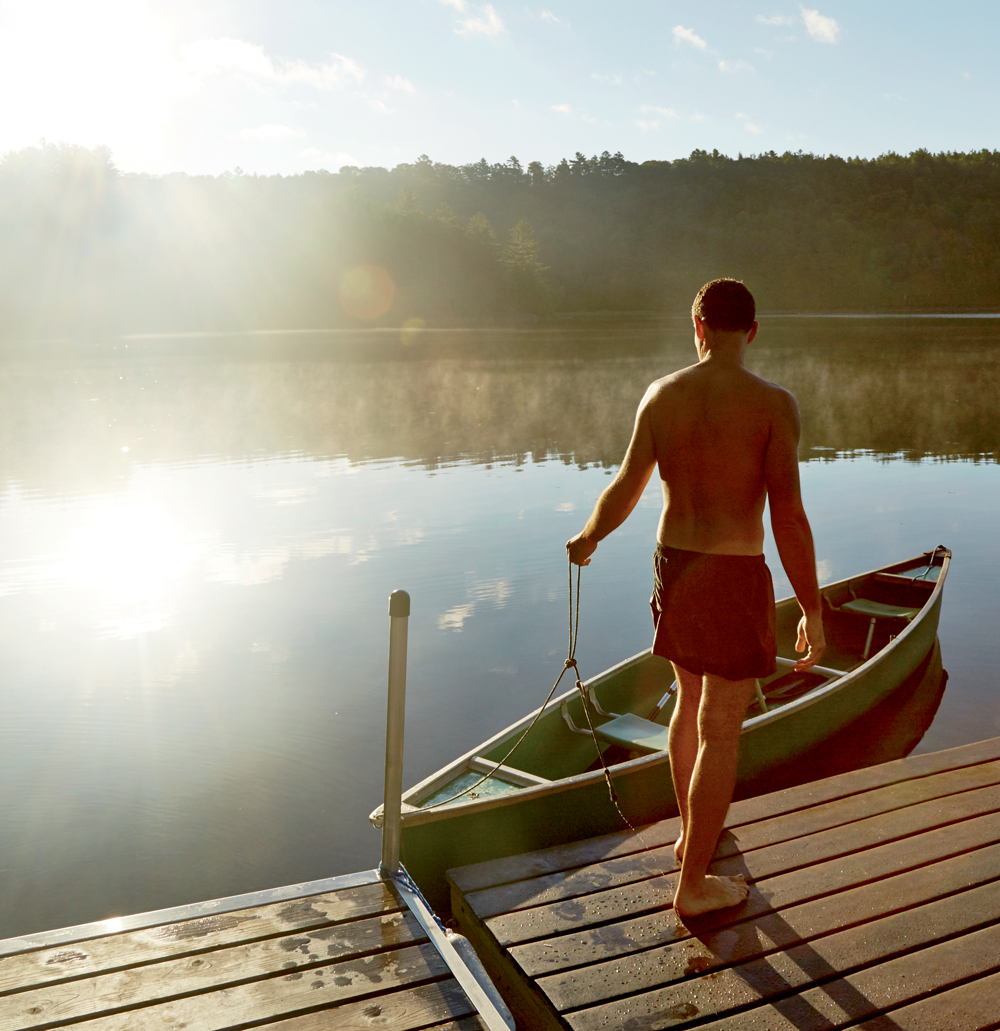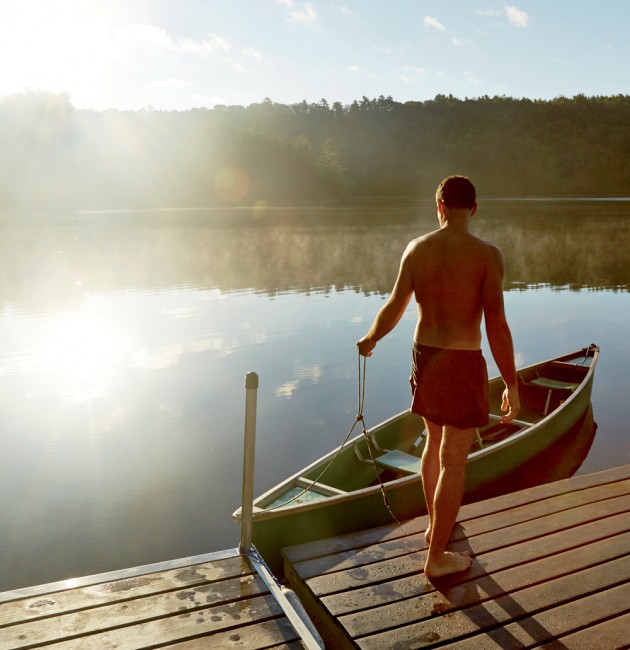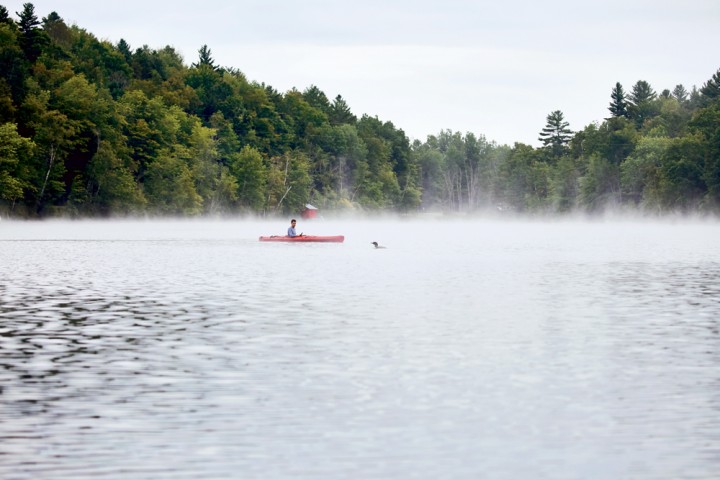Mirror Lake
When you live beside a New England lake, each season brings its own special intimacy. These are the mornings I’ll remember. The sky is already lit at 5:00 a.m., the lake like glass. Mist hangs in the hollows on the far shore, ghosted in the water below. No one else will be up for hours. […]

An early morning in
August finds the author
on his dock on “Number
10 Pond,” officially known as Mirror Lake, in north-central Vermont.
When you live beside a New England lake, each season brings its own special intimacy.

10 Pond,” officially known as Mirror Lake, in north-central Vermont.
Photo Credit : Adrienne Anderson
These are the mornings I’ll remember. The sky is already lit at 5:00 a.m., the lake like glass. Mist hangs in the hollows on the far shore, ghosted in the water below. No one else will be up for hours. I scooch my feet over the slippery rocks on the edge, then glide out into cool, green space, each arm stroke spraying whitewater. The mirror unzips before me, and my widening V rocks the sky. The lake bottom drops away, 40 feet, 60 feet, gone, until I’m just a tiny flier between heaven and earth. Technically, I know, even summer days end, but right now the lake is an infinity pool.
We bought the house for the lake. The house was everything I’d sworn never to take on—a 160-year-old farmhouse no longer square in any corner, with single-pane windows, a nest of snakes in the flagstone basement, and electrical wires sheathed in … could that be cloth? But it didn’t matter. It was in North Calais, on Number 10 Pond, a body of water I’d kept tucked in the back of my mind since childhood. I’d grown up two towns away, swimming happily in a typical Vermont mud puddle, but a few times we’d driven by Number 10 and I’d stared at the hills reflected in its stony depths and thought about the lives led there. Thirty years later, my wife mentioned an old Cape that was coming up for sale. No way in hell, I said. It’s on Number 10 Pond, she said. Buy it, I said.
And so we and our 4-year-old son found ourselves with a rickety white house and a downright dangerous dock pushing out into freakishly clear water. On a blistering June day, I dove in, clawed my way to shore, and pronounced it unswimmable: ice water.
That’s the nature of Number 10, which you won’t find on any map. That name, bestowed by settlers on the body of water beside the 10th of the town’s 14 one-room schoolhouses, officially ended in the 1960s, when the State of Vermont upgraded all the ponds in our area to lake status. Overnight, Dog Pond, Sabin Pond, Nelson Pond, and Number 10 Pond became Valley Lake, Woodbury Lake, Forest Lake, and Mirror Lake. You won’t catch locals using those names, but the state got one thing right: Number 10 is half a mile across and 106 feet deep. It’s no pond.
The depth makes it cold and clear. Its forested sides rise steeply. As above, so below, as the ancient mystics used to say. Boulders and bass tumbling into the abyss. It takes the sun a long, long time to heat up all that water, and that’s what fooled me. Number 10 Pond is far from unswimmable. It just takes its own sweet time getting there.

the pond toward the middle, where they rise skyward like souls.”
Photo Credit : Adrienne Anderson
That first spring, loons nested on Number 10 for the first time in decades. We liked watching them cruise by our dock, their chick clinging to Mom’s back or scrambling behind, the symbolism too obvious to even need mentioning. Mom and Dad took turns diving under and coming to the surface with minnows for Junior. We fed our kid Goldfish and let him paddle near the dock in arm floaties.
We’d lived in nice places before, but this was different, and the first time we listened to the loons wail like wolves through the night, we knew we were lifers. Everyone needs something in the landscape to orient by: a mountain, a garden, a lake. We took our cues from Number 10’s mood. Was it a swimming day? A sailing day? A day to simply watch the light play across the surface? We named every corner. Birch Point. Cedar Shore. Loon Lagoon. We discovered the log where the turtles like to sun, and the water lilies where the catfish gang hides out. When our son and his friends got bigger, we sent them to the rope swing on their own.
But mostly we swim. We like to say that we enjoy the lake in every season—there’s the occasional miraculous Christmas ice skate—but let’s face it: November through April is an acquired taste. Mostly we leave it to the ice fishermen, unmoving black specks on a grainy white scrim. For us, rebirth comes in April, when the ice breaks up and the loons come barreling in like overenthusiastic summer people. I don’t know how they get the word at their Atlantic winter quarters, but they arrive as soon as the first channels open. They don’t even have enough runway to take off again, though when the ice gets soft, my son and I launch our canoe and use it like an icebreaker to help them. They hang tough until late fall—the parents leaving first, the kid a few weeks later, just ahead of the ice.
Swimming starts on some unseasonably toasty May day. You know you’re pushing it, but you can’t resist. You stand on the dock, trying to absorb whatever heat you can into your pasty skin; then you overrule your self-preservation instinct and leap. You pretty much bounce off the surface and wind up just where you started, gasping, but it’s a beginning. The next day, you jump again, paddle out 10 strokes, then beat a quick retreat to the dock, your feet aching. Then you take stock of the situation, confirm that you didn’t die, and do it all over again, maybe 12 strokes this time.
By June, weather gods willing, you can really swim. It’s still freezing by Homo sapiens standards, but one of the great lessons of New England lake swimming is that it’s all in your head. You can make the choice to turn off your freak-out software. This is me, thrashing through wicked-cold water. This is me, breath caught short. There’s nothing like plunging into a cold lake to snap you right back into your body. There’s no better cure for the wandering mind. You couldn’t be more present, your heartbeat booming the seconds underwater. It’s terrifying, but I have yet to meet the person who dives into the icy lake, climbs out, and says, “Gosh, I wish I hadn’t done that.”
Early in the season, I keep an eye out for the loon chicks, bobbing along like gray rubber duckies. That first year I got too close, and the dad shot over and howled in my face, chasing me all the way back to the dock. He was a nervous new father back then, yodeling at kayakers and the resident eagle and night shadows 24/7. The loons started with two chicks and ended the season with one. We all blamed the eagle, though it would never have held up in court. The eagle just sat in its favorite pine tree, stone-faced. Now we’ve been here 12 years, and we’re practically empty-nesters ourselves. We’ve seen them fledge two chicks some years, none others. We try not to get too attached.
By July, I forgo showers, slipping sleepy-eyed into the water first thing. Armies of mist march in lines from the edges of the pond toward the middle, where they rise skyward like souls. By midmorning they burn off and the wind buffets the surface into thousands of steely grooves. Swimmers and paddleboards crisscross and bake in the sun. July is when you get strong and tan, powering across the lake two, three times a day. I’ve swum to cocktails on the far side, like the protagonist in John Cheever’s story “The Swimmer,” then swum back in the gloaming, feeling invincible. On steamy nights we run down the dock and fling ourselves into the starry ink, a Double Dipper above and below us.
And then one day something has changed imperceptibly. It’s still summer, but that little shower that came through last night must have been cool, because the lake doesn’t feel quite as silky as yesterday, and when the sun slips behind a cloud, you shiver.
In September the lake is warmer than the air and the fog is absolute. I pad down the wet path, feet numb from the grass, and dive into an undifferentiated white ether, no shore, no sky, water striders flicking away like TIE fighters. The loons cackle out of the fog. I stroke through nothingness, and then turn and find my way back, Adirondack chairs coalescing out of the mist, and I haul myself back onto the dock, towel off fast, and pull on jeans, trying to get my heat back.
And then comes a day when you can’t do it. Some dreary morning in the 40s. The shower beckons, warm and uneventful, but it also feels like the day your aging parent decides not to go for the daily walk. Just not up to it. After that, there are always the Indian-summer moments, the midday dips into shock, but you’re fighting a rearguard action. You know how it ends.
The loons pull out in November. There’s no ceremony. Mom and Dad take off, leaving Junior bobbing in confusion, never having flown in his life. By then, the water is so cold that it churns like oil. Swimming is done, but we can’t let the pond go, so in the short afternoons we canoe through fleets of crackly yellow leaves skating across the surface. The young loon blinks in the failing light, his feathers still patchy with adolescence. Fly, we urge him. Fly. But really that’s only part of us talking, the rational part that knows it’s the nature of things, that it has to happen. We try to ignore the other part, the part that can think only about how very quiet it will be around here soon, the part that has been whispering all along, Stay.


